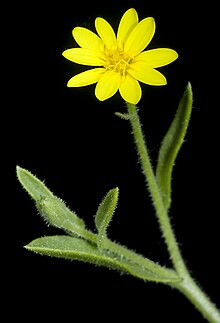Osteospermum calendulaceum is a plant in the family Asteraceae.[1] It was first described in 1782 by Carl Linnaeus the Younger.[1][4] In 1832, Christian Friedrich Lessing assigned it to the genus Oligocarpus in his Synopsis Generum Compositarum.[1][2]
| Osteospermum calendulaceum | |
|---|---|

| |
| Scientific classification | |
| Kingdom: | Plantae |
| Clade: | Tracheophytes |
| Clade: | Angiosperms |
| Clade: | Eudicots |
| Clade: | Asterids |
| Order: | Asterales |
| Family: | Asteraceae |
| Tribe: | Calenduleae |
| Genus: | Osteospermum |
| Species: | O. calendulaceum
|
| Binomial name | |
| Osteospermum calendulaceum | |
| Synonyms[3] | |
| |
In South Africa, it is native to the Cape Provinces, Free State, KwaZulu-Natal, Lesotho, Northern Provinces and Eswatini. It has been introduced into Hawaii, South Australia and Western Australia.[3][5] In Australia, it is an agricultural weed found mainly on arid lagoon shores and plains.[5]
References
edit- ^ a b c d "Oligocarpus calendulaceus". Australian Plant Name Index, IBIS database. Centre for Plant Biodiversity Research, Australian Government.
- ^ a b Chr. Fr. Lessing (1832), Synopsis Generum Compositarum (in Latin), unknown, p. 90, doi:10.5962/BHL.TITLE.51470, Wikidata Q6136846
- ^ a b "Osteospermum calendulaceum L.f. | Plants of the World Online | Kew Science". Plants of the World Online. Retrieved 29 September 2023.
- ^ Linnaeus, C. [filius] (1782), Supplementum Plantarum, p. 386
- ^ a b A. Ghafoor (2020). "Oligocarpus calendulaceus". Flora of Australia. Canberra: Australian Biological Resources Study, Department of Agriculture, Water and the Environment. Retrieved 12 November 2021.